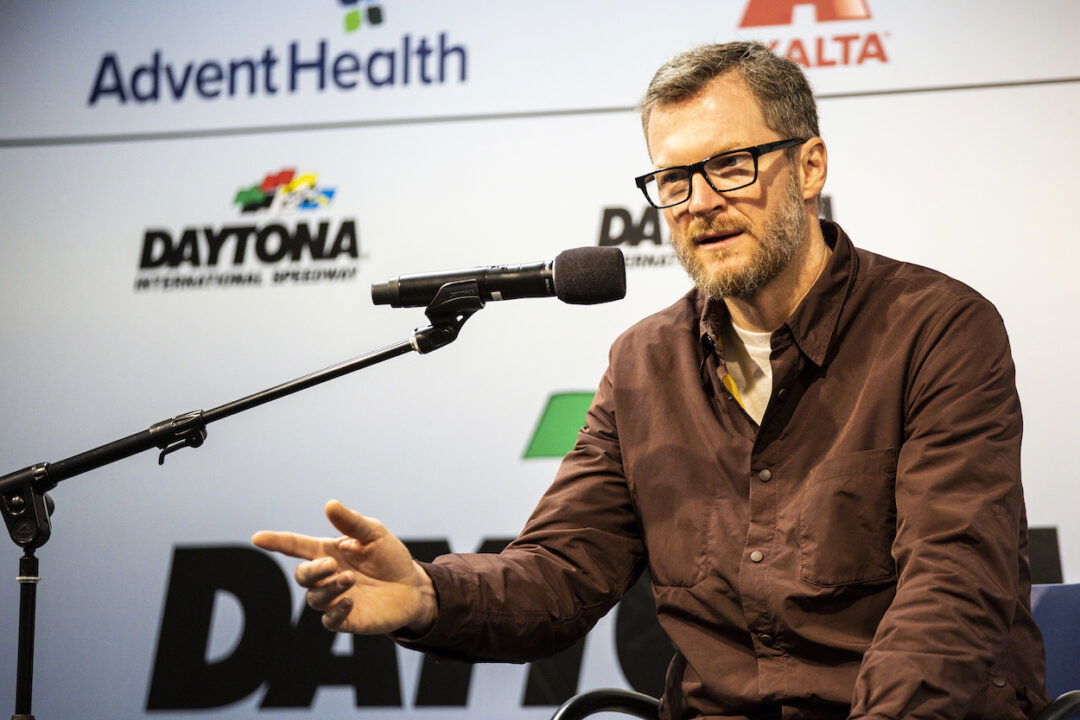
Getty
DAYTONA BEACH, FLORIDA – JANUARY 12: Dale Earnhardt Jr., driver of the #5 Hendrick Motorsports Chevrolet, speaks to the Media during the NASCAR Next Gen Test at Daytona International Speedway on January 12, 2022 in Daytona Beach, Florida. (Photo by James Gilbert/Getty Images)

Getty
DAYTONA BEACH, FLORIDA – JANUARY 12: Dale Earnhardt Jr., driver of the #5 Hendrick Motorsports Chevrolet, speaks to the Media during the NASCAR Next Gen Test at Daytona International Speedway on January 12, 2022 in Daytona Beach, Florida. (Photo by James Gilbert/Getty Images)
Dale Earnhardt Jr.’s voice carries weight in the NASCAR garage, where his insights often prompt teams and officials to pause and listen. His recent address was on Ram’s comeback: with Chevrolet, Ford, and Toyota as the current OEMs in the Craftsman Truck Series, Dodge is poised to become the fourth through its Ram brand. Dodge first entered NASCAR’s Cup Series in 2001, achieving success like the 2012 championship with Brad Keselowski. But financial struggles led to their exit after that season. But does their comeback road look clear?
Watch What’s Trending Now!
Ram officials have expressed enthusiasm for rejoining, with NASCAR’s John Probst noting, “I know that this is something that we have been talking about for a long time, and it’s something that we don’t get to do very often.” As Ram partners with Kaulig Racing for a multi-truck entry in 2026, a series of concerns loom. Dale Jr. highlights one critical issue standing out. So what’s his key warning?
ADVERTISEMENT
Dale Earnhardt Jr.’s engine concerns for Ram
On the Dirty Mo Media podcast, Dale Earnhardt Jr. voiced serious doubts about RAM’s engine readiness for a competitive Truck Series return. He pointed to the challenges of updating outdated power plants, drawing from Dodge’s past. “I wonder, how does their power plant and their motor, their V8 from years ago, where’s the technology? How does it measure up to where we are today with what we’re building?” Dale Jr. asked.
This stems from Dodge’s 2012 Cup exit, when economic pressures forced withdrawal despite a title win, leaving engine development stagnant for over a decade. Dale Jr. emphasized the gap in evolution, noting current engines differ vastly from Dodge’s era. “Because what the motor you raced when Dodge was here years ago isn’t the same motor we race now,” he added. While trucks use Ilmor NT1 spec engines, easing entry, Dale Jr. warned that scaling to Cup could falter without quick adaptation.
His background as a two-time Xfinity champion and team owner lends credibility, recalling Toyota’s initial struggles in Cup after a smoother Truck debut in 2004. The concern ties to Ram’s ambitions beyond Trucks, potentially eyeing Cup by 2028. “I think as they go further, I don’t think they’re going to mess with the Xfinity series. I’d be surprised if they enter the Xfinity series. But I think once they get the Cup, now that program will have a hard time getting going,” Dale Jr. explained.
ADVERTISEMENT
This echoes Dodge’s history of rapid success in Trucks, winning manufacturer titles in 2001, 2003, and 2004, but facing hurdles in higher series due to engine parity rules enforced by NASCAR. Developing a modern Cup engine to match today’s technology will be difficult, especially with NASCAR’s strict oversight to keep all manufacturers equal. While Ram can thrive quickly in trucks, their long-term success at the top level will depend on solving these engine hurdles.
But while Dale Jr.’s take raises questions about Ram’s path forward, he also offered ideas on fixing other NASCAR issues, like superspeedway racing.
ADVERTISEMENT
Dale Jr.’s superspeedway stage fix
Dale Earnhardt Jr. floated adding a fourth stage to superspeedway races to curb fuel-saving tactics. He argued this would ensure shorter segments, pushing drivers to race harder. “The only way you could probably do that for the rest of the race was to be able to add a fourth stage, which some people talked about. Like at Charlotte, 600, we have four stages,” he said. This draws from the Coke Zero Sugar 400, where Ryan Blaney’s fuel strategy overshadowed speed.
The idea aims to reward outright pace over conservation, especially at tracks like Daytona. Dale Jr. noted, “That guarantees me as a fan that I shouldn’t see my driver and all the drivers riding around at half throttle, because they can get to the end of the stage without running out of fuel.” Critics of current stages point to disrupted flow, but his proposal could enhance excitement, similar to the Coca-Cola 600’s format.
ADVERTISEMENT
Fans remain split on stages, with some favoring uninterrupted runs like Bristol’s 235-lap green flag stretch. Dale Jr. stressed, “We need to add an extra stage in these races to end this fuel-saving cr-p.” As NASCAR evolves, this concept could reshape superspeedway dynamics, prioritizing aggression and skill.
ADVERTISEMENT
ADVERTISEMENT
ADVERTISEMENT

